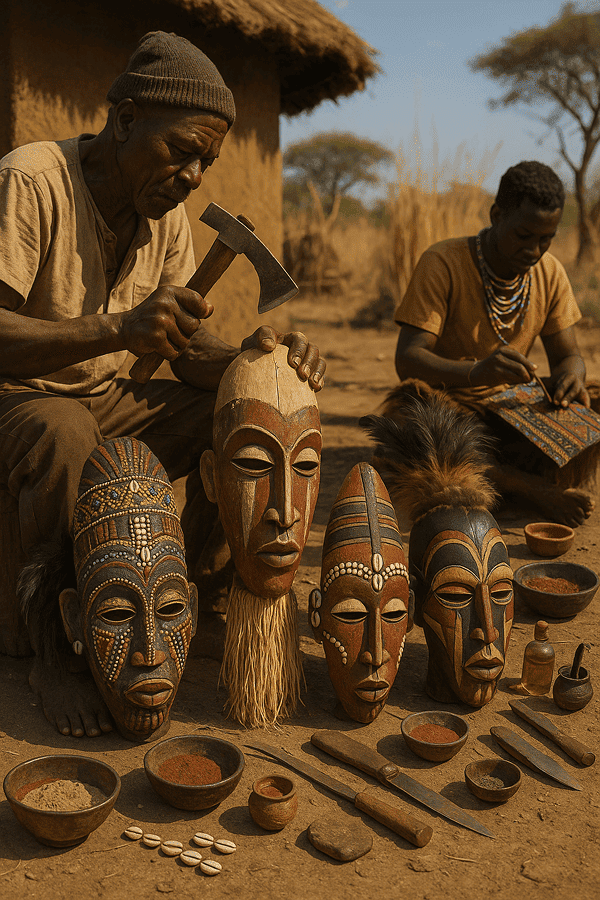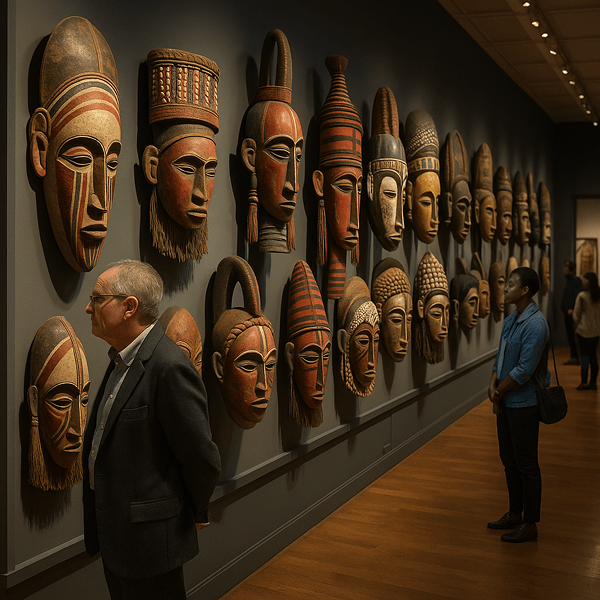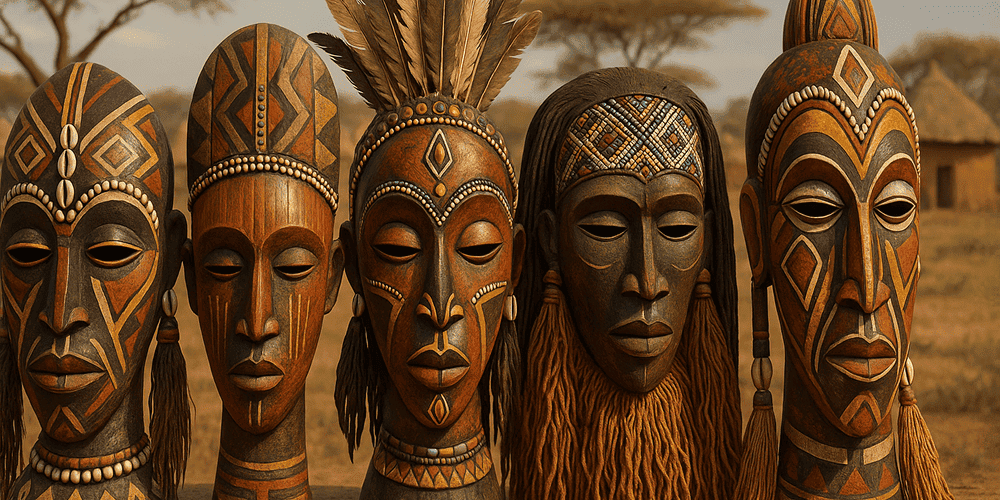South African Masks are among the continent’s most fascinating and evocative artifacts, representing a wide spectrum of artistic, spiritual, and social traditions. These masks are typically characterized by bold, geometric shapes, intricate carvings, and vibrant coloration using earth tones, whites, reds, and blacks. Many feature stylized human faces with elongated features, prominent brows, and elaborate headdresses, while others depict animals, spirits, or mythological beings. Masks are an essential part of the cultural heritage of South Africa’s diverse ethnic groups, including the Zulu, Xhosa, Sotho, Ndebele, and Venda peoples. The tradition of mask-making in the region can be traced back several centuries, developing alongside important rites of passage, healing ceremonies, and communal celebrations.
Historical Origins of South African Masks
The history of South African Masks is deeply rooted in the region’s indigenous cultures, which have long used masks as powerful tools for ritual and storytelling. The very word “mask” is translated into local languages such as “isifihla-buso” (Zulu) or “sifuba” (Xhosa), meaning “face-hider” or “to cover the face.” Archaeological evidence and oral traditions suggest that the use of masks dates back to the pre-colonial era, when small chiefdoms and tribal societies flourished across southern Africa. As societies evolved, masks became more specialized, serving in spiritual, social, and political contexts. Over time, their designs and functions adapted to changes in religious beliefs, colonial encounters, and urbanization. Noteworthy artifacts include wooden and beaded masks from the Zulu and Venda peoples, as well as rare clay and metal masks discovered at archaeological sites. While South African masks have their own distinct identity, they also share certain forms and functions with West African traditions like Bambara Masks, highlighting the interconnectedness of African mask cultures.
Cultural Significance and Symbolism of South African Masks
South African Masks carry profound symbolic meaning, functioning as mediators between the human, spiritual, and natural worlds. In many cultures, masks are believed to be inhabited by ancestral spirits or deities during rituals, allowing the wearer to channel supernatural power. Masks are central to initiation ceremonies, marking the transition from childhood to adulthood and imparting moral values and communal identity. Animal masks often embody strength, wisdom, or fertility, while human masks may represent ancestors, healers, or legendary figures. Myths and legends frequently explain the origins of specific mask types or the powers attributed to them, often involving stories of creation, healing, or transformation. The social context of mask use is deeply communal: performances, dances, and ceremonies bring together entire villages, reinforcing social bonds and transmitting tradition across generations.
Materials and Craft Techniques of South African Masks
Traditional South African Masks are made from a variety of natural materials, including hardwoods (such as kiaat or stinkwood), clay, leather, and plant fibers. Beads, feathers, animal skins, and shells are often added for decoration and symbolic effect. The crafting process typically begins with the ritual selection and preparation of materials, followed by careful carving, smoothing, and painting. Artisans use tools such as knives, adzes, chisels, and sometimes even fire to achieve the desired shape and surface texture. Special techniques include beadwork (especially among the Zulu and Ndebele), incised patterns, and the application of ochre or plant-based dyes. Regional differences abound: Ndebele masks are renowned for their geometric beadwork, while Venda masks are noted for their elongated forms and painted motifs. Color symbolism is integral — red may signify vitality or danger, white purity or the ancestral realm, black the unknown or the spiritual world, and blue or green harmony and fertility.

Functions and Uses of South African Masks
The functions of South African Masks are as diverse as the cultures that create them. Masks play a central role in initiation and coming-of-age ceremonies, where they protect, guide, and empower initiates. In healing rituals, masks are worn by diviners or shamans to communicate with spirits and diagnose illnesses. Masked dances and dramas are performed during festivals, harvest celebrations, and funerals, serving both entertainment and spiritual purposes. Over time, the use of masks has evolved: while some traditions have declined in urban and Christianized settings, others have adapted and found new life in cultural festivals, tourism, and contemporary art. Today, South African masks are celebrated not only as ritual objects but also as symbols of national identity and artistic innovation, featured in museums, educational programs, and international exhibitions.
Regional Variations in South African Mask Traditions
South Africa’s rich cultural landscape has given rise to a variety of regional mask traditions. Zulu masks are often large, angular, and adorned with colorful beadwork, reflecting both ceremonial and decorative functions. The Xhosa people create masks for initiation rituals, typically with bold geometric designs and white clay coating. Venda and Tsonga masks are elongated and stylized, used in healing and ancestor veneration ceremonies. In contrast, Ndebele masks are famous for their intricate beadwork and striking patterns, sometimes worn as part of elaborate costumes. Each tradition is shaped by local myths, environment, and history, yet all share the goal of connecting the human and spiritual realms. Compared to West and Central African masks, South African masks tend to be less anthropomorphic and more abstract, emphasizing symbolic meaning over literal representation.
Famous Examples and Collections of South African Masks
Some of the most renowned South African Masks can be found in national and international museums. The Iziko South African Museum (Cape Town), the Johannesburg Art Gallery, and the Ditsong National Museum of Cultural History (Pretoria) all house significant collections of traditional masks. Internationally, institutions such as the British Museum and the Smithsonian National Museum of African Art feature South African masks in their African art galleries. Notable historical finds include rare 19th-century Zulu and Venda masks, as well as unique beaded masks from the Ndebele. Private collectors and digital resources like toddmasks.com also contribute to the preservation and study of these cultural treasures, offering virtual galleries and expert insights.

Influence of South African Masks on Art and Culture
The influence of South African Masks extends far beyond ritual and ceremony. Their bold designs and vibrant colors have inspired generations of artists, sculptors, and contemporary designers. Mask motifs appear in South African painting, sculpture, textile arts, and even architecture, serving as emblems of cultural pride and resilience. In literature and film, the mask symbolizes hidden identity, transformation, and the interplay between tradition and modernity. Internationally, South African masks have influenced fashion, stage design, and the global appreciation of African art. Their continued presence in festivals, public art projects, and educational initiatives ensures their ongoing contribution to the country’s cultural heritage.
Contemporary Status and Preservation of South African Mask Traditions
Today, the tradition of South African Mask making is both challenged and revitalized. While urbanization, globalization, and religious change have led to the decline of some practices, many communities and artisans actively sustain and adapt their traditions. Master mask makers continue to pass down techniques through apprenticeships and family workshops. Cultural organizations, museums, and festivals play a vital role in supporting artisans and promoting mask culture. Innovative artists blend traditional forms with modern materials and themes, ensuring relevance to new generations. Educational programs, museum workshops, and online resources — such as toddmasks.com — help keep the knowledge and appreciation of South African Masks alive and accessible.
Collecting and Acquiring South African Masks
The market for South African Masks is vibrant, with authentic pieces available through artisan cooperatives, galleries, museums, and reputable online platforms. Prices vary according to age, craftsmanship, provenance, and condition. Collectors are encouraged to seek expert advice, verify authenticity, and prioritize ethical sources that benefit local communities and respect cultural heritage. High-quality reproductions and contemporary interpretations are also valued for educational and decorative purposes. Toddmasks.com offers guidance on collecting, authentication, and ethical considerations, helping to ensure responsible and informed acquisitions. Ethics are especially important: respect for sacred origins and local traditions must guide any collecting or purchasing decisions.
